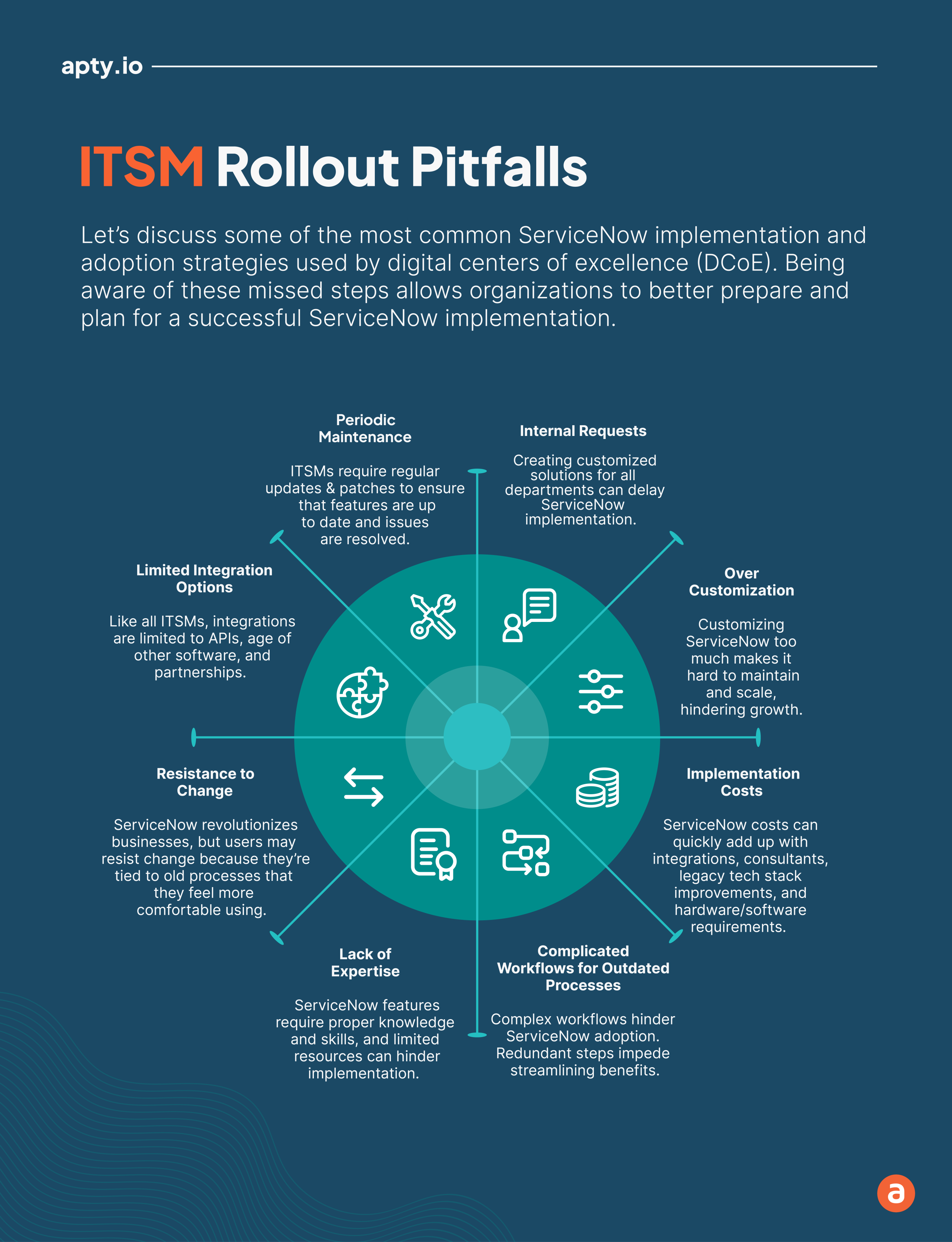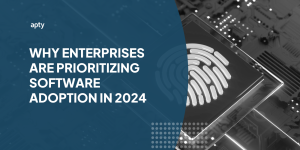What is ServiceNow?
ServiceNow makes work simpler by using a workflow engine powered by AI. It provides solutions through workflows for IT, Employees, and Customers. On top of that, with the Now Platform, you can build own enterprise workflows that you need. However, implementing ServiceNow can be challenging, particularly for organizations new to the platform or needing more IT expertise.
One of the biggest challenges of ServiceNow implementation is ensuring that the platform is configured to meet the organization’s specific needs. This involves understanding the organization’s business processes and workflows and customizing ServiceNow to automate and optimize these processes. This can be a time-consuming and complex process, particularly for organizations with complex IT environments or legacy systems that need to be integrated with ServiceNow.
Another challenge of ServiceNow implementation is ensuring the platform is properly integrated with the organization’s IT systems and applications. This involves identifying and resolving compatibility issues and ensuring data is transferred seamlessly between systems. This can be particularly challenging for organizations with large and diverse IT infrastructures, as they may have to integrate ServiceNow with multiple systems and applications.
Overall, implementing ServiceNow can be challenging and requires careful planning, expertise, and resources. However, with the right approach and support, organizations can successfully implement ServiceNow and realize the benefits of streamlined IT operations and enhanced service delivery.
In recent years, there has been a significant increase in demand for ServiceNow implementation across various industries. According to a study by Future Market Insights, the global ServiceNow market size is expected to grow from $4.4 billion in 2020 to $13.2 billion by 2025 at a Compound Annual Growth Rate (CAGR) of 24.8% during the forecast period.
This growth can be attributed to ServiceNow’s numerous benefits, such as improved efficiency, streamlined workflows, and enhanced collaboration. As more organizations recognize the value of ServiceNow, the demand for its implementation is expected to continue to rise.
Let’s examine some of the most common ServiceNow challenges while implementing and fully adopting ServiceNow as an IT service management (ITSM) solution.
Here are the nine common challenges faced during ServiceNow Implementation:
Let’s discuss some of the most common ServiceNow implementation and adoption strategies used by digital centers of excellence (DCoE) to overcome common pitfalls when rolling out an IT service management (ITSM) solution. Knowing these missed steps allows organizations to better prepare and plan for a successful ServiceNow implementation. Here are the nine common challenges faced during ServiceNow implementation:
- Internal Requests
- Over Customization
- Complicated Workflows and Outdated Processes
- Lack of Expertise
- Generic Training
- Resistance to Change
- Implementation costs
- Limited Integration Options
- Periodic Maintenance

1. Internal Requests:
When you implement ServiceNow for one of the modules in a department, other departments raise requests for the implementation. Creating customized solutions for each department will delay your implementation. The whole purpose of using ServiceNow is to maintain a seamless flow of information across the teams.
If organizations start entertaining these requests and go off the track with their vision, it creates chaos and affects the whole implementation process.
Solution: Maintain a seamless flow of information across the teams and look into overlay low-code software to speed up software change management.
2. Over Customization:
Excessive customization can make your ServiceNow installation difficult and expensive to maintain. Customizations can make expanding ServiceNow to new departments or organizational units challenging. It also makes updates to your system more time and labor-intensive as you have to ensure your custom code will work with the new version. 42% of consumers are annoyed when content isn’t personalized.
Solution: Prioritize features that meet business OKRs and digital transformation goals that affect revenue and business-critical processes.
3. Complicated Workflows & Outdated Processes:
The more complicated your workflows, the harder time you’ll have to adopt an ITSM solution like ServiceNow. Users need help to complete and understand complicated workflows; mapping them out in your software system is just as challenging. ServiceNow is designed to streamline your processes, but you can only reap the benefits if you create simple workflows. You’ll also need to update and integrate your processes with all relevant data points.
Without proper integration, the data flow across the teams could be affected. If one of the system is not integrated with the other, we might lose some valuable insights due to data silos. 94% of corporate company executives would prefer to utilize a unified platform to integrate their apps and implement process automation than rely on several platforms.
Solution: Do not build ServiceNow to accommodate current outdated processes. Use it to improve and transform, even if that means changing business processes. Monitor and track processes post-implementation for data-informed process optimization solutions.
4. Lack of Expertise:
ServiceNow has a vast range of featured solutions for each IT, Employee, and Customer workflow. Having the right knowledge and skills to accommodate those features might lead to better execution. An organization’s resources may be limited due to the constraints on its activities. While investing in the platform, companies should allocate the resources for training or outside consultants to ensure a smooth implementation without affecting ongoing projects.
Solution: Allocate resources for training to ensure smooth implementation.
5. Generic Training:
Generic ServiceNow training might not be tailored to your business and processes. Companies often make the mistake of training people on the software, but it is more appropriate to prepare the relevant team on how they can leverage the software to their advantage. Make sure your training fits how they’ll use the platform. According to 92% of employees, well-planned employee training programs have a favorable impact on their level of engagement.
Solution: Prepare teams on how to use the software to their advantage with personalized in-person and in-app training tailored to their job role and business use cases. Decrease digital friction with helpful self-paced guidance.
6. Resistance to Change:
ServiceNow revolutionizes businesses, but users may resist change because they’re tied to old processes that they feel more comfortable using. While ServiceNow can bring many benefits to an organization, getting employees to adopt the new platform is often challenging. This resistance to change can be due to several factors.
First, employees may be comfortable with their existing system and may feel that ServiceNow is an unnecessary disruption to their established routine. Additionally, employees may be concerned about their ability to use the new platform effectively and may resist learning new processes or systems.
The implementation revamps the way a business operates.
- The transformation it brings to the IT experience,
- The automation it provides to the HR, and
- The acceleration to the security,
But the users are reluctant to change. Most of us can’t handle that much change in a shorter interval. In a survey of 3,000 executives, McKinsey and Company found that 70% of all organizational transformations fail, and 70% of those failures can be attributed to the inertia of culture and mindsets.
Solution: Create a digital adoption center of excellence (CoE) to include all stakeholders before implementation to evaluate and address company culture. A change management CoE can also offer assistance hereafter implementation.
7. Implementation costs:
One of the significant challenges of ServiceNow is its implementation cost. ServiceNow is a complex platform that requires significant resources, time, and money investment. Organizations need highly skilled professionals to implement this platform successfully. Therefore, the implementation cost of ServiceNow can be a significant challenge for many organizations.
Solution: Purchase through a partner that includes consulting and implementing software add-ons that are known for their positive ROI and proven payback cycles.

8. Limited Integration Options:
Another challenge organizations may face with ServiceNow is the limited integration options. ServiceNow offers integration with other tools and platforms but may only integrate with some of the tools and platforms an organization uses. This can disadvantage organizations that rely heavily on other tools and platforms.
Solution: Take full advantage of all the software features and functionality by looking for cloud-based application overlays that don’t require immersive integrations to aid in your digital transformation goals.
9. Periodic Maintenance:
ServiceNow is a highly customizable platform that requires regular maintenance. Organizations must keep their ServiceNow instance up-to-date and ensure the platform runs smoothly. This can challenge organizations that need more resources or expertise to maintain the platform regularly.
Solution: Look for software admin experts within your organization and externally to maintain the software effectively. This is where a CoE comes into play.
ServiceNow is a powerful platform that can help organizations streamline their ITSM and business processes. However, it comes with its own set of challenges, such as implementation costs, limited integration options, and regular maintenance requirements. Organizations need to weigh the benefits and challenges of ServiceNow before implementing it in their operations

Importance of overcoming ServiceNow adoption challenges:
To fully reap the benefits of the powerful ServiceNow platform, organizations must address the challenges that may arise during implementation. Implementation can lead to low adoption rates, employee frustration, and wasted resources. However, organizations can increase their chances of success by planning carefully, avoiding unnecessary customizations, and partnering with experienced ServiceNow providers.
To further enhance adoption rates and overall productivity, organizations can leverage digital adoption platforms like Apty. With Apty, employees can receive personalized guidance and support while navigating through ServiceNow. This not only reduces employee dissatisfaction but also increases efficiency and ROI.
Successfully implementing ServiceNow can improve efficiency, cost reduction, and better decision-making, giving organizations a competitive edge in meeting customer needs quickly and effectively. With careful planning, collaboration, and the use of effective digital tools like Apty, organizations can maximize the potential of ServiceNow, resulting in better business outcomes.

Overcoming ServiceNow Challenges to Adoption with Apty:
Investing in the latest technology can be tempting for organizations looking to streamline their processes and improve productivity. However, simply purchasing a new platform like ServiceNow doesn’t guarantee success. Implementing and adopting the technology effectively is essential to see any real benefits.
One of the most significant challenges to successful technology adoption is employee resistance. Employees may be hesitant to learn a new system or process, especially if they are comfortable with the existing way of doing things. This can lead to low adoption rates, ultimately hurting productivity and ROI.
Apty offers a range of features that can help organizations increase adoption rates and improve overall productivity when using ServiceNow. One such feature is the ability to create interactive guides that provide step-by-step instructions for employees navigating the platform. These guides can be customized to meet different teams and departments’ unique needs, reduce employee dissatisfaction, & increase confidence in using the new system.
Apty also allows organizations to track user activity within ServiceNow, which can help identify areas where additional support or training may be needed. This data can then be used to create targeted training programs and improve the overall user experience. Apty can help address this issue by providing customized training and support materials tailored to an organization’s specific use of ServiceNow.

Furthermore, Apty’s analytics dashboard provides real-time insights into how employees use ServiceNow, allowing organizations to quickly identify and address any issues. This helps ensure that the platform is used to its full potential and that organizations achieve their desired outcomes.
In summary, implementing and adopting new technology like ServiceNow can be challenging, but it is essential to realize the full benefits of the platform. Apty DAP can help organizations overcome these challenges by providing real-time guidance and support, customized training, support materials, and many features to increase adoption, improved productivity, & business outcomes.
Relevant read: solutions to improving ServiceNow adoption












